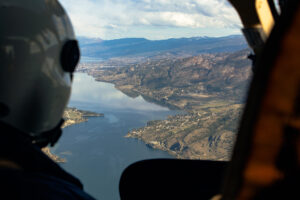If a state famous for canyons and cacti strikes you as an unlikely venue for vineyards, you’re not wrong. In parts of Arizona, though, the confluence of arid days, cool nights, higher elevations, volcanic soils and — most crucially — deep wells for drip irrigation renders the desert into an oasis for grapes. As a result, Arizona hosts a fledgling wine industry that aims to rival Napa and Sonoma, only without the pretentiousness or price tags associated with more established wine regions. Every winter, nearly a million Canadian snowbirds flock to this state for its warmth, rugged scenery and high-wattage sunshine; wine offers just another good reason to go south. In vino veritas, as the saying goes, and in Arizona vino.
I migrate there myself, albeit in August, to sample the truth of its wines. Leaving Phoenix on a road trip arranged by the Arizona Office of Tourism, the concrete sprawl of the city yields to open desert. The sky is a pale and cloudless blue, sapped of colour and texture by the heat (by 9 a.m., it’s 40 C). Mountains are dark suggestions in the distance — dark in part because conifers thrive in the cool relief of high-altitude outcrops known as “sky islands.” Along the road, dozens of ocotillo plants, a spiny, long-stemmed shrub, resemble explosions of green snakes from prank cans. Everything about the Sonoran desert of southern Arizona seems exaggerated, almost cartoonish, from the roadrunners speeding across the highway to the fleshy, shrugging torsos of saguaro cacti patrolling its shoulders.
The saguaro is the flagship species of the Sonoran desert, a unique ecosystem that sprawls from Central Mexico to the southwestern United States (there’s even a relict chunk stranded in British Columbia’s Okanagan). Home to yucca, prickly pear, staghorn and agave, the Sonoran looks surprisingly lush and green — at least during the monsoon season, when I visit. Every afternoon, dark purplish clouds bunch in the sky and bolts of lightning sting the horizon. The deluge that follows hints at how thirsty plants such as grapevines survive here: the Sonoran receives up to 38 centimetres of rainfall annually, barely qualifying it as a desert.
Heat is another matter. With summer temperatures climbing to 48 C, humans are a rare species in the Sonoran, clinging on only where there’s air conditioning. Take Willcox, for example, the former “cattle capital of America” and my first stop on the wine tour. This town of 3,700 boasts fewer cowboys than in previous eras, but exponentially more vintners. Fodor’s hailed Willcox’s twice-annual wine festival (held on the third weekends of October and May) as a “can’t miss” event. But fear not: if you do miss it, Willcox hosts year-round tasting rooms, and all of them are air-conditioned.
The batter-proof copper door, tin roof and polished hardwood floors hint that the Keeling Schaefer Vineyards tasting room was once a bank. Today, the building deals more in currencies of wine than cash. Hosting the tasting is Jan Schaefer, a charming, white-haired retiree who owns and runs the vineyard with her husband, Rod Keeling. In 2000, the couple bought land “45 minutes from nowhere” and planted vines based on what they’d learned through avid reading and a three-day oenology course. Fourteen years later, after producing some impressively sophisticated wines — rated “very good” by Wine Spectator magazine — Keeling Schaefer was crowned “winery of the year” by the Willcox Chamber of Commerce and Agriculture.
Across the street is the tasting room for Carlson Creek, a family-owned vineyard run by two young brothers from California. The elder sibling, Robert,
is 35; his brother, John, is 28. They pour me a glass of Sweet Adeline, a Riesling named for their grandmother, and explain how they came to run a vineyard. Robert worked as a stockbroker until the financial crash in 2008, when he decided to invest in what he truly loved: wine. Teaming up with his brother and family, the Carlsons bought 65 hectares just outside Willcox, and Robert has rarely spent time at a desk since. “We could never do this in California,” Robert says, citing the cheaper land and lower start-up costs for vineyards in Arizona than in his home state.
In that sense, the Sonoran desert is the final frontier of wine: anyone with a little land, a lot of savvy and reliable well water can live the vintner dream in Arizona — and even adopt a wallaby to boot. Asked how he afforded a vineyard at such a young age, Manning says “I got lucky — sort of.” At 12, he was hit by a car and received a five-figure settlement. With his parents’ guidance, he used the cash to buy a house in Phoenix, and sold it after college for many times its original price. He bought 16 hectares in Willcox and eight hectares in Elgin, planted vines, built a castle-like home (which doubles as a tasting room and production facility), rescued marsupials and countless other creatures, and began making award-winning wines. Among them is a red blend called Magdelena, named for his grandmother — apparently a nomenclatural trend among young Arizonan winemakers. Her response to his loving gesture? She said he got her name wrong (she goes by Lena) and that she prefers white wine. “At 96,” Manning says admiringly, “she’s still the biggest smartass I know.”








